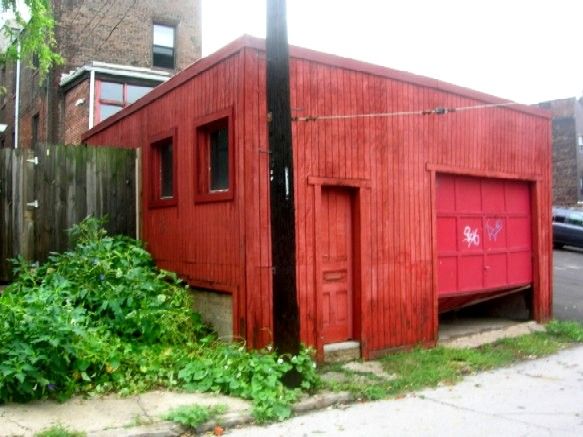
The unfufilled dream.
A little over a year ago my girlfriend and I bought an old row house in Pittsburgh. A disheveled beauty built right after the Civil War, we were won over by its tall ceilings and beautiful 8″ wide window casings. Oh, and it had a garage. Not just a garage, but a 500 square ft shop with radiant floor heating, 10′ ceilings, south facing windows and a 150 amp breaker box. Well, not exactly; I’m dreaming – the garage was a dump. Water leaked from the ceiling, there were mushrooms growing on the walls and the garage door was about to fall off. Regardless, the vision was clear – this was one day going to be a killer shop. The house was going to need a lot of work, but getting the shop together was on the top of my list of priorities.
Priorities change. In the past year my girlfriend became my wife, our first kid was born, we labored at our jobs, we labored on the house and the economy took a nose dive. All of these wonderful and not so wonderful things conspired to create the present situation – the garage is still a disaster and it doesn’t look like it’s changing anytime soon. Facing facts, I decided to set up my workshop in a 12′ x 12′ room in our basement.
The decision to commit to the room was a little slow in coming. I originally set up the basement space as a bench room with the beleaguered garage as a machine room. This was a decent arrangement until the weather turned, and then it became miserable. Nothing inspires bad woodworking like cold cast iron. I trudged through last winter and wasted a lot of time and good wood due to errant decision making – it’s hard to think when you’re freezing your butt off. I couldn’t repeat this situation. There had to be a solution (quit woodworking and take up knitting? macrame? scrapbooking? – I just don’t have the heart for any of that stuff). This fall, with winter looming I decided to jam my machines into the bench room. I was a little nervous. I knew I could fit it all in, but I wasn’t sure the arrangement of the machines would be functional (would they have adequate infeed/outfeed room? would I be constantly bumping into things?). Into the 144 sq ft room I packed a dust collector, air filtration unit, 6″ jointer, 14″ band saw, air compressor, portable finish planer, router table, drill press, grinder and mortiser. They fit, but it’s tight. Two pieces of equipment were just too big and unwieldy to bring inside – my table saw and my big band saw – so for some work I still have to make the trip out back.
Clearly, if I was a full time furniture maker this situation wouldn’t do, or if I was tall, it would be a nightmare – the ceiling is just under 7 feet. For right now, however, the situation works. There are even some benefits. I feel like the physical constraints of the space have made me a better, more disciplined woodworker. In a small shop you have to be organized. Every tool has got to have its place. If things just get left around it quickly becomes a disaster. The space constraints also force me to focus on the project at hand and work through issues. I’ve always been one to jump around and work on multiple projects at once. I like to think that this habit came from just wanting to quickly act on new ideas, but I know some of it is about avoiding a project when an obstacle arises (how am I going to deal with that tear-out? I’ll start another project!). I don’t have that luxury right now. I don’t have room for additional projects. I’ve got to work in a more linear fashion and address the hurdles as they come. Another benefit is that I’m able to stay closer to my family. My work in the shop is extracurricular to my job, so it cuts into my family time. The kitchen/dining room is right up stairs which allows us to stay tuned to one another while we’re doing our own thing. The biggest bummer for me is that I had to leave my table saw in the garage. I still use it, but increasingly, out of convenience, I direct what was table saw work to my band saw. My shooting board is seeing lots of action these days. This change has been a little awkward. Even though I love band saws (easily my favorite machine), the table saw is fundamental to the way I’ve come to work. For me, it’s the keystone of the shop for everything from sizing to precision joinery.
With a basement shop there are two functional issues that stand out: dust collection and electricity. Dust control is key in any shop, but in a small space it becomes even more important. There is simply less volume and it doesn’t take long to saturate the air with dust. When the shop is integrated into your home, the concern over dust amplifies. To control the dust I’ve got a single stage dust collector, an air filter, and a Fein vac for spot cleaning. I’m also religious about wearing a respirator. Electricity is another issue. My basement shop had only 2 outlets that were on the same 15 amp circuit. That wasn’t going to cut it – popping breakers I’ve had to add 3 20 amp circuits to handle the load. I’ve thought about adding a 220 line and re-wiring some of the machines.
Remember when Steve Martin urged, “Let’s get small!” Well, I’ve done it. I’ve gotten small. It works. One day that crappy garage out back will be a shrine to woodworking. It will have to be torn down and rebuilt, but it will happen. Until then I’ll continue to build, albeit little projects, in my basement workshop.
The Bottom Line on the Not So Big Workshop
Pros:
- It has instilled a more disciplined and organized approach to woodworking.
- Proximity to the other folks in the household (the kitchen is right upstairs – easy snacking)
- Keeping those bills low – I’m not paying to heat an additional space
- Convenience – I’m working on my house right now and all my tools are closer at hand.
- It was free! – I’ll need the $x0,000 I would have spent on the shop to buy diapers
Cons:
- Compromise on the size/quality of equipment – someone keeps putting an ad for 12″ x 7′ jointer on Craigslist – I feel like they are personally taunting me.
- Compromise on the scale of the work – the dining room table and the kitchen cabinets will have to wait.
- Not a good place to do finish work; a great place to kill off some of those pesky brain cells, though.
- Noise – (perhaps the whole househould should be issued hearing protection? Do they make ear muffs for babies?)
Not Sure:
- Change in building style. With the table saw outside I find myself taking a more bandsaw centered approach.
UPDATE: Responses to your questions from the comments below:
Eoin,
Thanks for the suggestion about putting the dust collector outside. I’m considering doing this. Between the shop and the back yard there is a small, unheated room that we use for gardening stuff that might be perfect for the dust collector. My reticence has been that I didn’t want to suck hot air out of the house. My winter heating bills are ridiculous – the walls of the house are uninsulated and I haven’t sealed all the drafts.
You’ve got your work bench in your bedroom? That is hardcore. You have got to put some pictures up showing your set up.
– Kevin
Mooseroo2,
You’re right; one of the nice parts of having a small shop is finding elegant storage solutions. When you find a way to tidy up an area it feels like hitting the jackpot. You’re right on, too, about how a smaller shop reigns in spending. If I was in a larger shop I would have no doubt blown more money on tooling that I really can’t justify right now given that woodworking isn’t my fulltime job.
Post those pics links to the planer station that you’re talking about. That might work out.
– Kevin
BuckeyeRob,
Mobile bases definitely make a difference. Though you might only be able to shift a machine a few inches this way or that, that minor adjustment can open a lot of infeed/outfeed room.
-Kevin
Thrashbear,
I’m in Uptown, in between Downtown and Oakland. The neighborhood’s a little shaky; we’re trying to rehab it, too, along with the house. Pittsburgh has been great for woodworking. There are great hardwoods all over this part of the country and the cost of living is low.
-Kevin
MotorT,
Right on! Things are good. It wasn’t so long ago that I was bumming space off of friends and family just so I could do some work. Having my own space, even limited space, is awesome.
Go Steelers! This weekend’s game vs. the Ravens should be sweet. A cold weather battle between two strong defensive teams with the winner going to Tampa. You’ve gotta love that.
-Kevin
m103,
Hahahahahahah . . . I just read your comments and started laughing when you wrote, “. . . your blue cupboard has only TWO tools hanging inside the door.” Clearly, there is room for optimizing; thanks for the suggestions. Another poster mentioned the light issue as well. I’m generally not a fan of flourescents, but the suggestions have me thinking about adding some to supplement the existing bulbs.
-Kevin
KlondikeMike,
That’s an old Grolsch bottle that I use to hold shellac polish. I love beer, but the only alcohol in the shop is denatured.
-Kevin


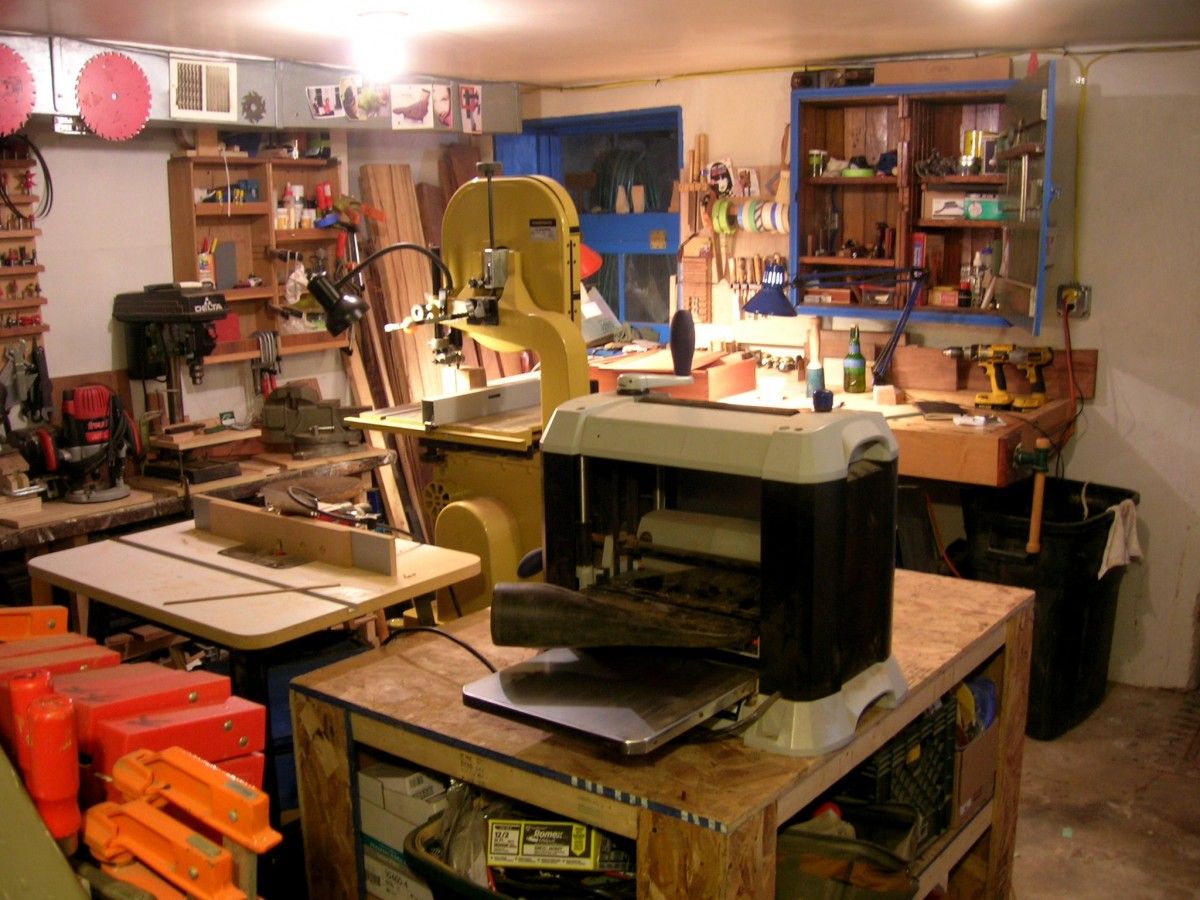

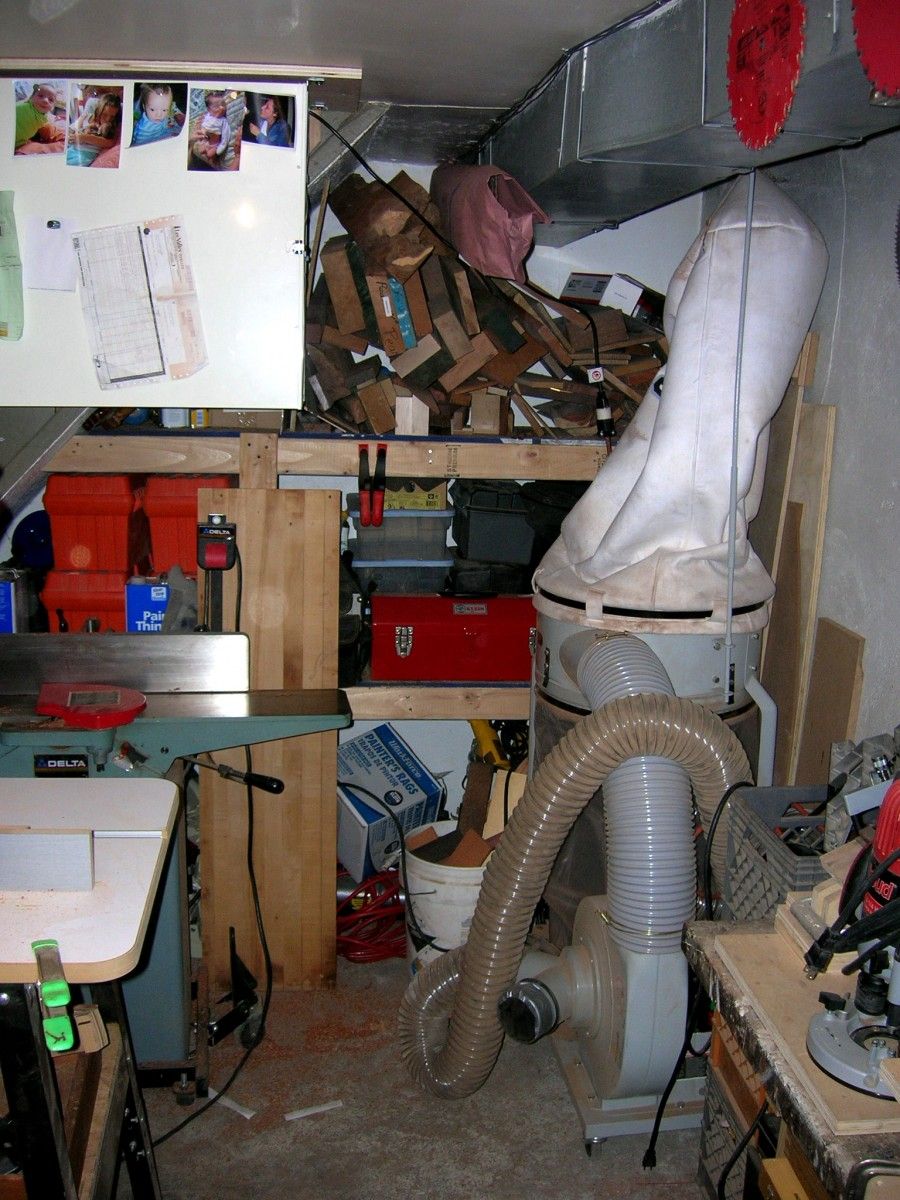


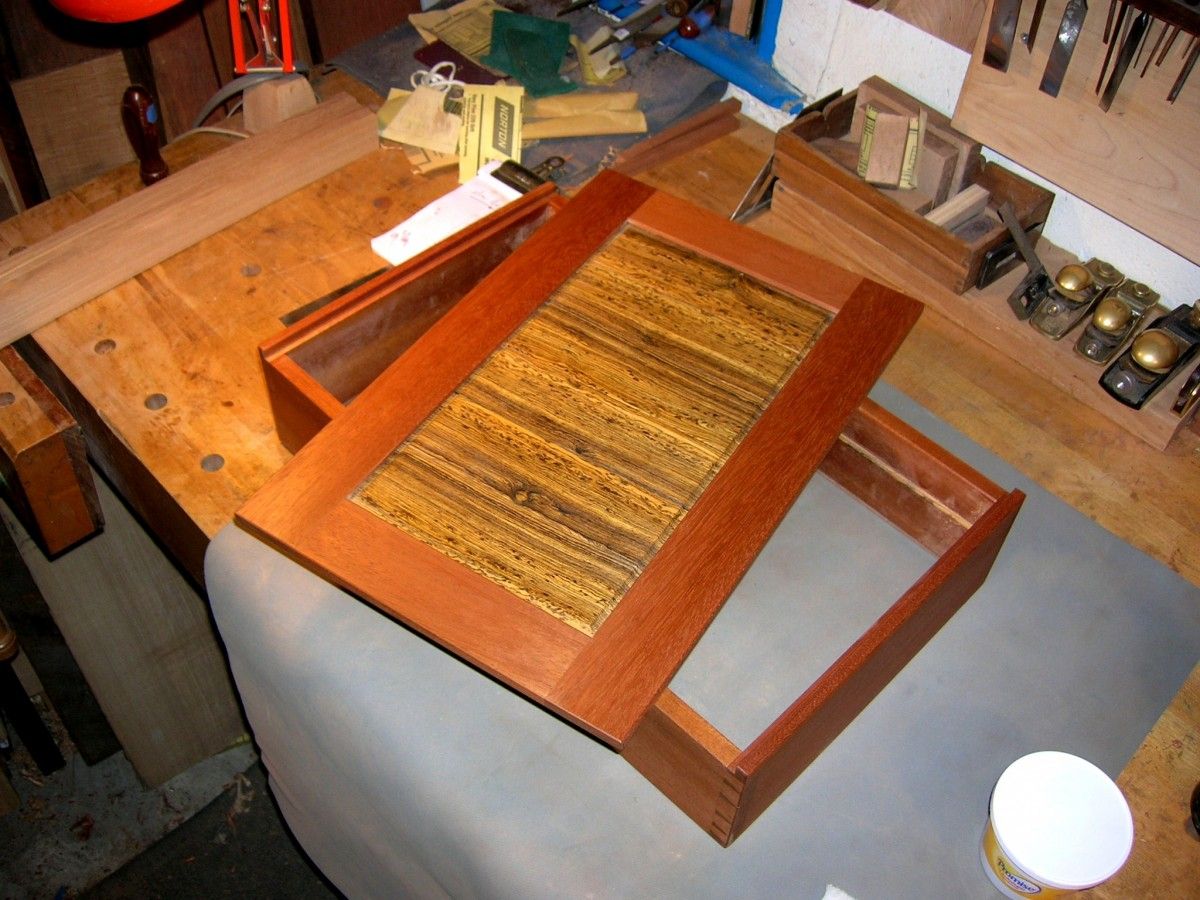


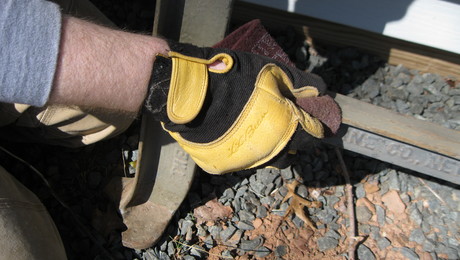
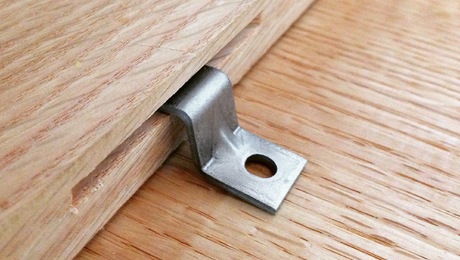
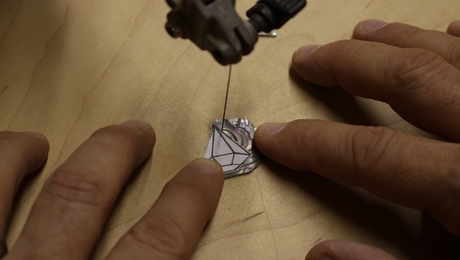


















Comments
Kevin, in “The Not So Big Workshop.”
I can assure you, you are not alone!
Sounds like you have given your situation a lot of thought and set some realistic priorities.
Keep the dream.
Larry
Hey there,
Would it be an option to move the dust extraction outside so as to free up space. Not sue how it would work in your climate but I've seen them set up in insulated plywood boxes to protect them from the environment and to protect the environment from any noise.
Just a thought!
Other than that, I feel your pain. I've got my workbench set up in my bedroom until I move to a more suitable place. No power tools allowed which is not such a bad thing...
Eoin
I've got my shop in a room just like yours in my basement... air ducts and all.
It does call for some sacrifices, but it also limits my expenses! I can't buy that big jointer I want (and probably can't really afford yet) because it just won't fit.
The best part is coming up with slick ways to store tools that uses minimal space.
Regarding your portable planer, I've seen a plan for a workbench where you mount the planer on a pivoting or hinged surface so that it hangs upside down under the work surface when not in use. If I can find it, I'll post another comment.
Cheers!
Just wait, as time goes by you will enjoy your small space even more. My current studio is 14' x 12' my previous space was 3,000sf in an old mill. I do not miss the large space, like you said you learn to be more efficient in your space. Years ago I would have never thought about working with hand tools, everything had to be large and powerful, table saw. large jointer, planer, sander etc. All those tools are no long gone and gave way to Japanese planes, saws and other various hand tools. 98% of my work now days is done strictly with hand tools not only because of limited space but because I enjoy the process of furniture making much more now with hand tools. Sure I sometimes miss the stationary machines but I wonder if I could have the skills I do now if I still had the space for them. For me a small studio was a blessing in disguise.
Keep up the good work, you have a great talent.
WEEL DONE!
OPPS... I MEANT WELL DONE!
Kevin, Thanks for sharing this! I think more emphasis needs to be put on small shop setup rather than large ones since that is what most of us have. My basement shop has exactly the same dimensions as yours. I have a table saw/router table, 8" jointer, 12" drill press, 12" benchtop style thickness planer, work bench, and miter saw. Like you, I was concerned about the infeed and outfeed distance requirements. I solved this by mounting everything on mobile bases. The only stationary piece is my bench. I bought some carts with drawers and hardwood tops from Sam's to mount the drill press and miter saw. These carts also double as infeed and outfeed tables for the tablesaw. They have locking casters to hold them in place. I corrected the heights to match the tablesaw perfectly. As you mentioned, the close quarters force me to organize and keep things clean. 6 years on a Navy destroyer taught me that! I built a tool chest with drawers to fit under the bench. Full extension drawers 30" deep and 28" wide with customized dividers give me nice storage space for all the small items right at the bench. Each cart has drawers that I can dedicate for items relating to that particular piece of equipment. The only real concession that I have had to make to date is to substitute a large shop vac for a hard-piped dust collector. I simply hook it up to each piece of equipment as I use it. The only piece of equipment that I still need to buy is a bandsaw. Once I have that and a powered air filter, I will be set! A good filter mask solves that problem in the meantime.
Kevin, My advice is never stop doing woodwork, improving your skills, and improving on your shop. The day will come that you build a new garage/shop. Here are some things to consider from my experience developing a woodshop in a small space. My shop is contained in a three car garage. That sounds big but my wife has other ideas. It is really not big enough for three cars in the first place, nor big enough for all our stuff stored their, and my shop. In a pinch you can get two cars in along side my shop, but that has not occurred in a long time, and never really possible in our new house (garage is smaller). Now, normally only the wife's car lives in the garage at night, and her space includes my sheet good storage. The normal garage stuff is on a huge shelf, 3x15', hung from ceiling on chain. Boxes of stuff and a large TV cabinet that I build currently prevents use of the other car space. No garage has the size for all that a family needs. Or, the stuff we can't part with that continues to accumulate in what I call my space - the garage! My shop takes up 10x15.5' of floor space with 8'ceiling. In that shop square footage all the garden tools, a water shoftener, and our extra fridge take up space and have nothing to do with my woodshop. The remaining 4.5x10' of the one car space is taken up with storage of other stuff not related to woodworking, and that stuff is only accessable if you open the garage door.
Consider a Shopsmith. The big space saver in my shop is my 510 Shopsmith and it makes my shop possible. You may want to consider the economics of replacing some of your machines with a Shopsmith (see Shopsmith.com) and selling those that it would duplicate in capability. The Shopsmith provides excellent capability and accuracy and only takes the floor space of a 10 speed bike. Individual machines take up a lot more floor space. The Shopsmith provides a 10 inch table saw with removable table extensions, a lathe, a drill press, a 10 inch circular disk sander, and a horizontal boring machine, as standard. Many attachments can be added and that use the same basic motor/system. I love my Shopsmith because of all its capabilities. I am able to change from one system to another in less than a minute. I have been impressed with it's accuracy and space saving attrubutes for a long time (purchased mine new in 1996). Shopsmith gave me a 6" bandsaw attachment almost $600 value (6" cut limit and 10.75" throat) for free when I bought the system new. You may not want to part with your 14" bandsaw. If you had a table saw maybe a smaller band saw would due. Check out the Shopsmith home page. My bandsaw is usually on the machine, even when not in use and takes up no space. I created a place to store the bandsaw, quick and easy, on a corner of my assembly table. My shop consists of the following: I have as small 48x24x36"hi work bench(a machinist vice and no wood vice - with 8 drawers below for small tools. A 40x21" router table with storage below for saws/extra router, routing jigs (it serves as an outfeed table for my Shopsmith. A 10" radial arm saw and stand I made that is almost never used (I should get rid of it). A 66x32x30" and 22"hi assembly table w/8 drawers for power tools, hand tools, supplies, router bits (I keep a bench 4" belt sander on the lower section and my chopsaw on the top section of my assembly table most all of the time). A 24x28x30"hi cart with a small compressor on top, short clamps and bandsaw blade storage on sides and back, a storage drawer and space for power tools like a bench sander, grinder, chop saw or a planer (but I do not have one) below. A 48x28x18"hi toolbox that has three graduated smaller toolboxes in side it plus storage trays for hand tools, power tools, drillbits, blades, painting tools and supplies, etc. And, I have a rack on the wall for clamps and clamp-on straight edges shorter than 48", levels, and storage shelves. I use a large Sears shop vac (does not fit in my shop space anymore) that I hook up to the Shopsmith, when needed. A Shopsmith could inprove you limited shop space utilization, and I found it to be the best economical choice to boot for the small work shop and capability to do most any woodworking task.
Wood storage. I see wood standing on end in a corner in your shop. I would also suggest you consider a wood rack hanging from the the wall or ceiling of your shop (7' ceiling is not much) to free up the floor space and provide a place for your stock to become climatized to the level of humidity in your shop. At only 7' ceiling hight your are very limited in ability to hang something from the ceiling. My storage racks are three double rectangle hoops of 1x hang down 16" from the ceiling (I have 8'4" ceiling), are spaced almost 4' apart, screwed into the ceiling joist, and right over my Shopsmith. I can get 8'lumber in and out of the rack because I have 20' of clear air space to accomplish the task. They can hold and support lots of 1x 8' to 12' stock. I placed them in a way to be able to accept and remove boards, support them adequately constructed of good quality wood and enough screws. I also found additional uses under the rack for storage attachments for other things, like a runner for a clamp-on light to provide high intensity flood light on the specific area where I am working (mine runs right above the Shopsmith - the light can be moved over the table saw or bandsaw tables. I also store clamp-on 48" straight edges under the wood rack. You may find other things to add to it or hang from it near your ceiling, for ready access, like ear protection equipment, etc. I also have one rack for relatively small pieces of sheet goods over one of the car spaces that never sees a car. Your shop seems limited to a wall storage system for lumber. My advice is figure out and effective use for that air space as lumber storage, and free up the floor space.
Lighting. I see a few bare light bulbs in your shop. They produce harsh light. Lighting looks to be a problem too in your shop. Change them out to low profile florescents for better light and enough of them to provide less shadows.
Assembly area. Where do you assemble larger porjects, and where do you cut sheet goods? I have a great space advantage over your shop, when no cars are in the garage. I have four saw horses, kept outside, and I cut most sheet goods with a skill saw in the garage, using two clamps, a spacer gage, and my great old possession, a 1"x4"x8' piece of pine, which is straight as an arrow (been using it since 1980, when I built my second home). When I have a large project in process and partially assembled or being stained and finished, there is still room for the wife's car at night. Where do you assemble or cut anything larger than you can accomodate on your workbench?
Efficient storage. I can see from construction of some of your work benches that you have to dig to find stuff. I see the potential of wasted air space that could be better used for storage. I see wide supports (and no drawers with small face frames) on your work benches and storage areas. I use such space by thinking hard to come up with storage design and in trying to use all the volume I can within work benches for full extension drawers, etc. You may want to someday consider redesigning and rebuilding some of them to make more efficient use of the volume, using quality drawer guides and face frames with as little as possible. I found I could solve the problem with 1" wide face frame stock, drawers with less than 1/2" lips, and solid bottoms, backs, and sides. The closed fronts of drawers in workbenches keep things inside easily and readily accessable, clear of the accumulation of sawdust, and make cleaning the shop easier with everything on wheels.
Cussioning the floor, not or cold. I suggest you get good quality floor mats which can easy the load on your feet, knees, and hips. It will help keep you working more confortable and longer. We are all getting old at the same rate and joints are where it is really at when it comes to age (I's 64).
Mobilize everything. "Everything" in my shop is on wheels, including the Shopsmith. I would think you already have everything on wheels, so you can make room to assemble your larger projects in your small shop.
Plan before you build. I redesign every one of my projects on paper several times, before I get started making sawdust. I learned woodworking from my Dad, and he was continually making improvements on his designs until he passed the point in construction that it prevented changes. If significant functional improvements were possible, he would find a way to rebuild. He recognized when it was good enough, and when it was not possible and accepted that fact. But, he never stopped thinking how to improve his work, especially when it was possible he would build the same project again, and better. I am proud to say I have some of his work, completed when he was in junior high school. If he was still alive he would be 95 years old.
Hoping you find some of my advice useful to you,
Mitch
Hey Kevin, may I ask what part of Pittsburgh you live in? Reason I ask is because I have a buddy on Troy Hill who could have written this article almost word-for-word. I've been to his basement shop where he's currently in the process of remodeling his house. Last I saw he was living in one room in the basement and the rest of the house was torn down to the framing. His shop was packed toe-to-toe with lumber and tools, and good luck even turning around!
I am a full-time woodworker and furniture maker working out of my home. I find myself fortunate to have dedicated my 2-car garage as a workshop, but these Cleveland winters are hard to deal with without a reliable heat source. So I copped one 10 x 20 room in my basement as an assembly/finish room. Now I divide all my milling and dust-kicking jobs to the garage, and my "quiet" and clean work to the basement.
Despite this, it's still not enough! What I wouldn't give for a 10-foot ceiling. I do a lot of big furniture that is taller than my meager 7-foot 3-inch ceilings, so final assembly needs to be done outside on the driveway. Not easy when there's 12 inches of snow and subzero temperatures predicted this weekend.
Prior to this, I worked out of a 1-car garage, where it didn't take long for my work to spill into my house. Being a bachelor, I didn't have a spouse to answer to for furniture parts lying around the living room, or a steamer perpetually set up in the kitchen. I don't have that option now, but it's still head and shoulders compared to my previous workspace.
Hey Kevin, look at it this way, it is yours. Your young, You have a shop, a family, a home. You live in Pittsburgh, and the Steelers are in the playoffs and one game fromt the big show. So grab a Rolling Rock and enjoy.
All good things take time.
Kevin I just did the opposite of you by going from the basement to the detached garage over here in the Bristol twnshp Pa. This was caused by many choices the biggest was the smell of the finishes that flowed in the house. And the fact that my wife still doesnot understand why tabletop(tablesaw) conversation really a not good thing when I am working. The pics look great and if its works for you thats good and it must hae been fun. I know my 11X18 (188sqft) shop had its challenges. However I hope you enjoy your place because it s a great thing to your own shop right near the kithechn coffee maker.
A fellow Pittsburgher, I have a similar (12x12+low ceiling) sized show that I actually had Marc feature on The Wood Whisperer (search for "Mantown"). My only comment is that until recently I had my table saw in the garage, and the situation really stunk. Any time I wanted to cut something I had to move a car, drag the saw into place, clean up the dust, and it made my garage a mess. So I bit the bullet and the tablesaw is on a good rolling "box" stand, and I even built a router table into the right wing. I also use the left wing as a place to mount a Kreg pocket hole jig. The one big advantage I have is double doors that lead out under the deck, so I can open them when I'm cutting something too long to fit in the room. What I'm getting at is that not having to go to the garage to use the saw changed my woodworking abilities tremendously. Of course, I don't have a band saw...or decent dust collection....
Hi Kevin,
What amazes me here is that in the age of cable TV dream shops, we all need a reminder that most of us "real people" are constantly bucking the same exact space/organization issue. I'm a fan of the small in-home shop personally -- it definitely limits how many in-progress projects can be set aside before something *HAS* to get finished! I have to agree with others too -- the skills one can hone using hand tools instead of constantly reaching for the machines are priceless.
I freely admit I grew up shop spoiled -- was totally shocked the first time I visited a friend whose parents DIDN'T have a shop in their basement. [Oh you just need your dad to drill a hole in that. What do you MEAN you dad doesn't have a drill press?] Your babe is going to grow up with a far different view of the world than their peers, and kudos to you for it! I can't imagine not knowing the things I know from years of being my dad's "extra hands". How do those people function? heh!
I see your shop has a ceiling. If you can drop those panels temporarily or access your floor beams from outside of the shop, you can do some very quick things to limit noise in the rest of the house, such as feeding some strips of styrofoam sheet insulation between your floor beams, or if you can hit some good salvage -- sound deadening ceiling tiles chopped down to fit the gaps. (am I seeing right? looks like melamine coated masonite? -- great for lighting but horrid for sound if not insulated)
Having been in the Army, I have some "pro" experience with the issue of [how much can I possibly fit into this space and still function?] You definitely have some dead space issues going on there that you might want to spend a little time at the kitchen table with some quadrille before moving anything else around. If it's possible to adjust your machines to a more even feed height, one good set of shop horses could solve some feed space issues for you, allowing you to group your machines much more tightly abreast. I also see your blue cupboard has only TWO tools hanging inside the door. That's a whole lot of hanging tool space that you aren't taking advantage of YET.
I have to agree with others on the harsh lighting/shadow issue. I would suggest keeping an eye on craigslist and other similar places for some 4-foot fluorescents. Even if you run into a bad ballast, new ballasts are cheaper than brand new shop lights.
Don't read me as the great doomsayer. I'm just the 30-something daughter of a Capricorn mechanical engineer who was raised from the cradle on this stuff -- like I said: "shop spoiled". I see lots of things that can be improved-on, but I think you've already done a great job too :)
~m
Interesting stuff, these small shop posts. I have a small shop. You want to know how small? So small I can't get the tape measure in to find out. Seriously though. I've thought about putting a dust collector outside in an unheated space. My concern though is dampness in the filter bags making them unable to pass the clean air freely and reducing the effectiveness. I'll live with the heat loss if I can get rid of the dust. I'm also thinking about an air cleaner. Any comments on operating cost in terms of filters. Appreciate comments on both questions. Thanks, Jeff
I appreciate all the input regarding using a small space for woodworking. I'm currently in the process of setting up a new shop that will replace my old farm building that burned down in '07. I agonized over dedicating only 300 sq ft to the woodworking portion of the new building but am finding that less can be at least as good if not better, because organization is a must, and mobile bases aren't the worst thing in the world.
Kevin -
I will stop complaining now, or not nearly as loudly. My 9.5'x18' (171 sf) heated & air conditioned shop does have 11' ceilings (nice for wood racks) and double doors leading out into my garage. But I do have my table saw in the middle taking up much of the floor space.
I am planning on building a table saw extension bench with modular insets for router, sanding, vices, storage - and doing away with my workbench along the . This will make it easier to walk around it. right now I can only walk one one side of the t-saw.
Also, my central vac doubles as my dust removal system and it is hung on the wall a few feet away in the garage. But I will tone down my complaining, I will still dream for more space along with the rest of you.
I also have a small basement shop (although I have high ceilings which makes all the difference when working with sheet goods). A few things that I have done to save space:
- I built a stand with locking casters which houses my router table on the top and my 12" thickness planer on the bottom. I still (after over 10 years) have not built the planned bottom hinged doors which will support the outfeed tables but the system works well since I have fashioned blocks of the correct height to support my outfeed tables preventing snipe.
- I also built a benchtop which slides onto the angle iron that supports the fence on my table saw (obviously when the table saw is not in use). This makes a perfect platform for gluing, clamping, sanding, handheld router work & finishing.
- I use the space between the ceiling joists and have shelves attached to both sides of the support beam to store wood (sorted by species).
Kevin, Nice work and my sympathies -- you really have to deal with a SMALL and limited space. Hopefully what I did will give you some ideas that you might use.
My situation wasn't quite as bad as yours since I had a separate 12x16 shed to work with. But I did include all your tools AND my table saw. One of the first things I did was to add a door so that both ends of the shop can open for long space when needed. To do that, I had to add an exterior 6x12 covered deck that also gave me more workspace (exterior sanding station and clamping space). I moved the dust collector outside to that deck and routed its ducts underneath the shop. Finally, I added on a separate room for assembly and finishing -- an additional 9x10 space for a total 182 sq ft plus deck space.
You've gotten a lot of good suggestions and you can see what I've done at my website: http://www.beauhavenwoodworking.com/bh_views.htm . I'd suggest moving the dust collector out asap. To minimize heat loss, I added a filtered air return at the top of the closet to recover some of the warm air -- not perfect, but better than freezing air replacing the heated air.
I hung stuff all over my shop trying to fill all wall space and every corner (even ceiling corners). Since open air (natural light) is important to me, I have many windows which limited that space utilization, but you can see it still works out.
My last suggestion is to re-look at getting that garage rebuilt, reworked, or at least some usable space (finsh area?). My total cost for the 9x10 addition was $1400. I purchased studs etc. new as required, used all my leftover sheet goods as available, and especially took advantage of our local Habitat for Humanity store (visited several times a week). The large corner windows (while not matched in size or type) are Low-E and cost me only $130. In fact, the custom tempered glass itself for my converted folding French doors ($10 each) cost me as much as those windows. It doesn't show in those older pictures, but I've added full size tempered glass inserts in my double opening front doors by using the glass from shower doors contributed to the Habitat store (tempered glass can't be cut, you must get an acceptable size). $1400 for a 9x10 workspace, fully insulated seems like a pretty good deal to me. Oh, and that also includes large floor to ceiling built-in storage cabinets along one wall which provide sides to my spray booth vented through a speical window I made and an additional airconditioner and air cleaner for the room. Stunning what you can get for $1400 if you really try.
One other thought I had for you and others who have a shop inside your home using the same HVAC system. Be sure you use a 1 micron filter in your cold air return. You don't want your family breathing that micro wooddust whatever the chances you are willing to take.
Is that a bottle of beer on the workbench?
Kevin,
Like you and many of the others, I use my basement. I thought I was cramped until I read your article, and now realize that at 15' x 18' I am fortunate. I share my woodworking space with the washer and dryer, a heat and air system, yard and garden tools etc.
Looking for "found space", I have installed cleats across the overhead floor joists for lumber and long pipe clamp storage. I see that you have finished ceilings, but perhaps you could create removable panels in a couple of areas and utilize the joist space. One other "found space" is an area where the stem wall/basement wall connects to the crawl space under the front part of the house. I am in the process of building some cabinets into that space to house, among other things, my portable planer. If yours isn't a full basement, you may be able to cut an opening into the adjacent crawl space and box in a couple of simple cabinets. The 4' shop lamps ended up being the most cost efficient and functional lighting solution for me.
Could you provide some more details about how you expanded the electrical capability of the shop? I need to add some dedicated circuits for machinery, but am unsure how to progress.
Of all of the benefits you mentioned, I believe the proximity to the rest of the family and ease of access to kitchen and facilities is the best part. It is easier to duck downstairs for little bit than it was to go out to my garage at my previous house. Good luck and enjoy!
Why does FWW use a type color so grey that I can hardly distinguish it from the background white. It seems "greyed out." I'd love to read the articles, and the posts; but this is too much of a strain.
Can't find the issue among the FAQ.
K
Hi Kevin! Also a fellow Pittsburgher, my wife and I own an old Victorian in the Parnassus section of New Kensington. I started woodworking a few years before I met my wife. I bought this home shortly before meeting her, but I wasn't doing much serious woodworking, and as a result great shop space was not high on my list of priorities for the house. Fast-forward several years to now, when I find myself deriving a lot of joy from working with wood, and have taken over most of the basement as shop space. While I am lucky to have a little more space than your shop, I have the same issues with headroom, electricity, lighting, and usable space (old basements often have funky and hard-to-modify shapes, as I'm sure you've noticed). Of course, add to that the usual water entry during heavy rains, and my shop space is pretty far from dream-worthy.
I've found good ways to work in my shop, including on some larger projects. I need to devise better wood storage and build myself a real workbench. I need to figure out a better way to do fume extraction when finishing (the open basement door to the steps leading up to the back yard makes things a little chilly in winter). All in all, though, I don't know if I would have it any other way. There's a lot to be said for being close to my wife and the comforts of home, and our cats like to play "shop cat" with me (making sure to take lots of sawdust and cobwebs up to the main floors with them, of course).
Dealing with the small work space is a work form in and of itself. It looks like you're doing a good job with yours.
Perhaps someday those of us in the area should get together to share some Pittsburgh-style workshop issues, solutions and stories.
jonathan
I feel your pain as I work out of an 11x13 room in the basement. It is unfinished, and I'm considering doing it, but that may make the room even smaller. I jammed 3 small workbenches, a table saw, small band saw, and an older shopsmith. I felt like I was reading a story about my workshop here except for family situations. I plan on doing a big reorganization, as i don't have room right now for a mortising machine. I was thinking possibly eliminating one bench (made of 2x4's) and replacing it with some sort of shelving unit to store some of the smaller machines (router table, mortiser, mini lathe)
Oh well, enough rambling, We did enjoy stopping in Pittsburgh a couple of years ago on the way home, enjoyed the Dusquene incline at about 11pm, did get lost in a not so nice neighborhood, but all went well.
Nice job organizing a small space, and a fun read!
Re: finding a good spot to keep the portable planer ... I made a plywood with casters dolly for mine. To keep it sawdust-free & out of the way, I put a plastic cleaner bag over it & roll it in under my jointer (or shove it to a different unused corner when I fire up the jointer).
It only takes 30 seconds to roll it over, lift it off its dolly & set it up on a workbench, assembly table, or tablesaw when I need it. Could that work for you?
Dan
I teach woods at a high school. The table saws were down for weeks one time (electrical issue and stuborn electricians). Bottom line is I used the band saw for all ripping (gave it a 1/8 - 1/4 " wider than desired width) then ran the rip on the router table to get a great straight edge. (note that the router table fence is set so the board goes between the fence and the bit. This means that the board is fed in opposite direction than if you had a bearing on the router bit and were using it). This produced glueable edges. It worked so well I use this solution sometimes rather than geeeting out and setting up the table saw in my small home shop. It has kept me and my table saw out of the Oregon rain lots of times. The extra step of the bandsaw rough width reduces waste and makes the router bits last longer.
I feel your pain. I have almost the same situation. I have a few more square feet(about 15), but share the short headspace and basement location. We can build the same stuff "Norm" does, just have to do it differantly. Hang in there, your shop looks great for the amount of space you have.
Not sure if this is possible as I'm not a wood worker YET! I'm a designer of sorts so take what I say with a grain of salt.
"m103" mentioned putting all of your working surfaces at the same height. I totally agree with this. Something I might include would be to maybe place each tool on wheels and make it so you can "slide" the tool into place and share the same surface for all cuts, trims and what have you. Also, what about making a tool cabinet for your wall that has a hinged table top that doubles as the door of the cabinet? That way if you are not using those tools or are not needing that table you can fold in out of the way when not in use. This would give you more floor space. Build a clap rack on the roof so they are out of the way but still accessible. I agree with putting the vacuum outside if you can.
Over all I think you have created yourself a great place to work.
Sorry for any confusion of what I said in my last post.
I said "clap rack" when what I meant was "Clamp rack"
I'm surprised at Ckirstieshopteacher's comment about running the workpiece between the router bit and the fence to true the edge of a bandsawn board. I think that is a dangerous practice. The router could grab the board and throw it.
A flush trip router bit and a guide is much safer.
Log in or create an account to post a comment.
Sign up Log in